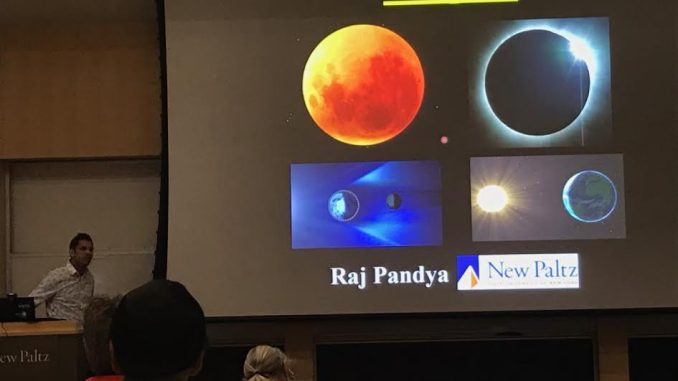
On April 8, from 2:11 – 4:35 p.m., the moon’s overlap with the sun in a total solar eclipse will be visible from New York for the first time since 1925. SUNY New Paltz astronomy professor Raj Pandya will host an eclipse viewing event starting at 1:45 p.m. on Old Main Quad to celebrate the occasion.
“Eclipses are a great way for people to get involved in observing,” said Pandya. “It gets people thinking about the universe in a bigger context than just our daily lives.”
Pandya has been studying astronomy for 15 years and has taught at New Paltz for 13. The more he learned about eclipses, the more fascinated he became. He held a panel in anticipation of the eclipse on April 3, where he discussed the science behind eclipses and how best to prepare for the upcoming eclipse.
The eclipse will be visible throughout New York State, but New Paltz will only see a 94% overlap. One would have to travel upstate to view the full total eclipse. The nearest city with a full view of the event is Syracuse. The eclipse reaches completion around 3:25 p.m.
Pandya explained that eclipses happen almost on accident. It makes the event feel somewhat miraculous. The Sun and moon are such different sizes, and yet an eclipse allows them to align perfectly. Other planets do not exhibit this phenomenon. “It’s like a fluke,” Pandya said.
Eclipses have always been a point of interest in human society. Once feared, sometimes worshiped and sometimes sparking wars — they have now become a way for people to gather together and view the astronomical event happening before their eyes.
“It shows our progression as a human society,” said Pandya. “As we learn more, we get to understand more that leads us to a happier life, where we’re not afraid.”
Pandya also pointed out the scientific breakthroughs that happened during eclipses. Throughout history, scientists were able to take advantage of eclipses to create interesting discoveries or prove certain theories. For example, the first documentation of the existence of the corona, or the sun’s outer layer, was taken during an eclipse. Einstein’s theory of general relativity was also proven during an eclipse.
“Einstein predicted that because the sun is a massive object, if you could see the stars during the daytime they would be in a slightly different position than they were at night,” Pandya explained. “During a total solar eclipse, it gets dark enough where you can see the stars and scientists were able to prove that during that time.”
To prepare, eclipse viewers should get certified ISO 12312-2 solar viewing glasses or view the eclipse through a telescope with a solar filter. SUNY New Paltz will offer both of these at the viewing event. While nothing about an eclipse is especially dangerous, Pandya said that people should always take caution when directly viewing the sun.
The next total solar eclipse will be visible in New York in 2045, making this eclipse even more special.
